automatic SKODA FABIA 2004 1.G / 6Y Workshop Manual
[x] Cancel search | Manufacturer: SKODA, Model Year: 2004, Model line: FABIA, Model: SKODA FABIA 2004 1.G / 6YPages: 247
Page 171 of 247
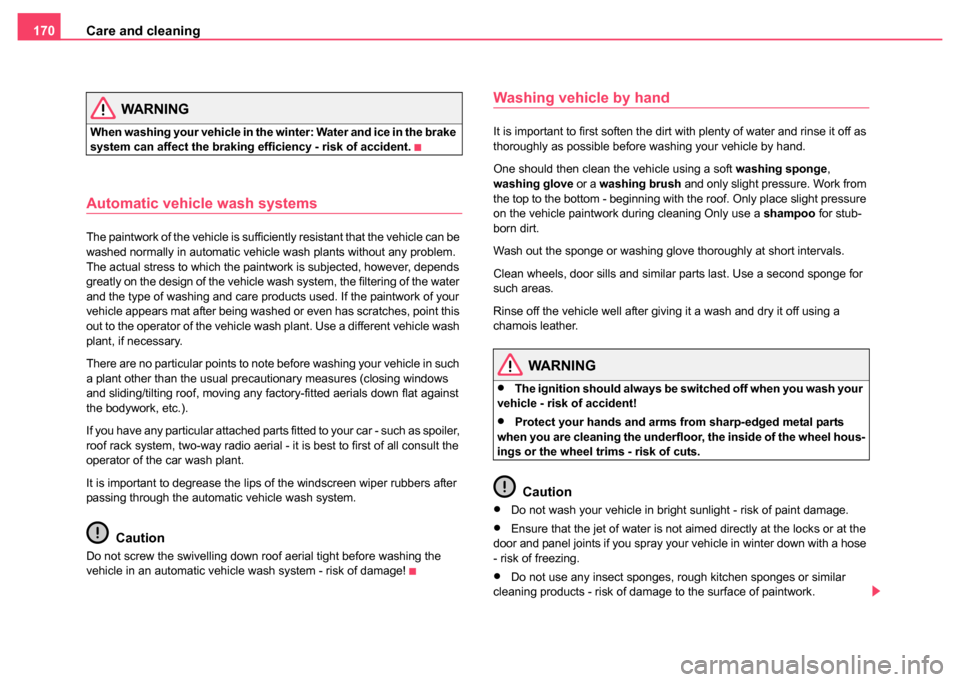
Care and cleaning
170
WARNING
When washing your vehicle in the winter: Water and ice in the brake
system can affect the braking efficiency - risk of accident.
Automatic vehicle wash systems
The paintwork of the vehicle is sufficiently resistant that the vehicle can be
washed normally in automatic vehicle wash plants without any problem.
The actual stress to which the paintwork is subjected, however, depends
greatly on the design of the vehicle wash system, the filtering of the water
and the type of washing and care products used. If the paintwork of your
vehicle appears mat after being washed or even has scratches, point this
out to the operator of the vehicle wash plant. Use a different vehicle wash
plant, if necessary.
There are no particular points to note before washing your vehicle in such
a plant other than the usual precautionary measures (closing windows
and sliding/tilting roof, moving any factory-fitted aerials down flat against
the bodywork, etc.).
If you have any particular attached parts fitted to your car - such as spoiler,
roof rack system, two-way radio aerial - it is best to first of all consult the
operator of the car wash plant.
It is important to degrease the lips of the windscreen wiper rubbers after
passing through the automatic vehicle wash system.
Caution
Do not screw the swivelling down roof aerial tight before washing the
vehicle in an automatic vehicle wash system - risk of damage!
Washing vehicle by hand
It is important to first soften the dirt with plenty of water and rinse it off as
thoroughly as possible before washing your vehicle by hand.
One should then clean the vehicle using a soft washing sponge,
washing glove or a washing brush and only slight pressure. Work from
the top to the bottom - beginning with the roof. Only place slight pressure
on the vehicle paintwork during cleaning Only use a shampoo for stub-
born dirt.
Wash out the sponge or washing glove thoroughly at short intervals.
Clean wheels, door sills and similar parts last. Use a second sponge for
such areas.
Rinse off the vehicle well after giving it a wash and dry it off using a
chamois leather.
WARNING
•The ignition should always be switched off when you wash your
vehicle - risk of accident!
•Protect your hands and arms from sharp-edged metal parts
when you are cleaning the underfloor, the inside of the wheel hous-
ings or the wheel trims - risk of cuts.
Caution
•Do not wash your vehicle in bright sunlight - risk of paint damage.
•Ensure that the jet of water is not aimed directly at the locks or at the
door and panel joints if you spray your vehicle in winter down with a hose
- risk of freezing.
•Do not use any insect sponges, rough kitchen sponges or similar
cleaning products - risk of damage to the surface of paintwork.
Page 185 of 247
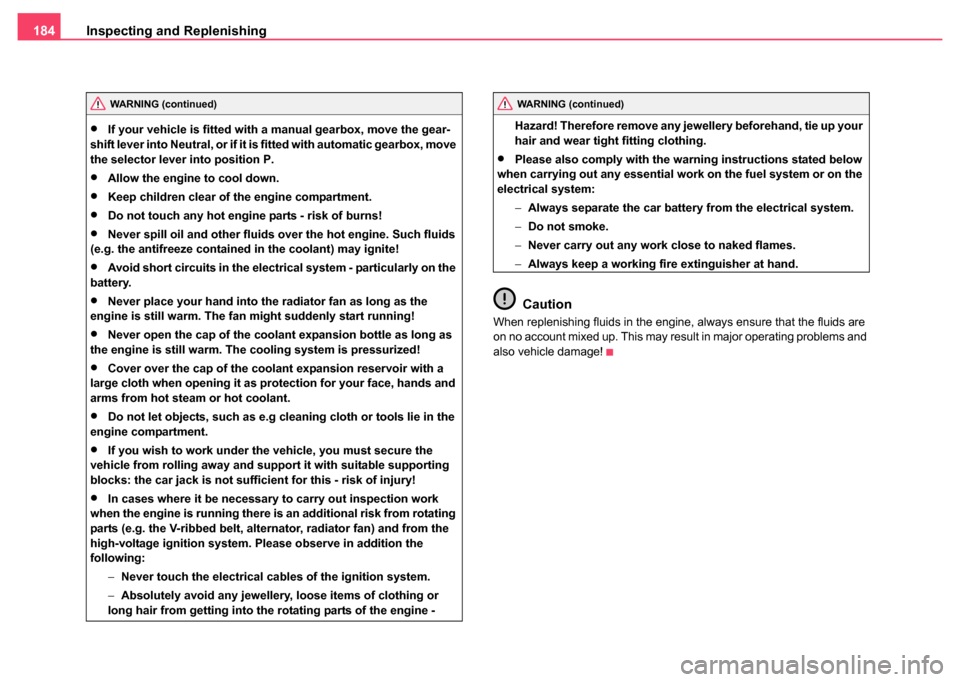
Inspecting and Replenishing
184
•If your vehicle is fitted with a manual gearbox, move the gear-
shift lever into Neutral, or if it is fitted with automatic gearbox, move
the selector leve r into position P.
•Allow the engine to cool down.
•Keep children clear of the engine compartment.
•Do not touch any hot engine parts - risk of burns!
•Never spill oil and other fluids over the hot engine. Such fluids
(e.g. the antifreeze contained in the coolant) may ignite!
•Avoid short circuits in the electrical system - particularly on the
battery.
•Never place your hand into the radiator fan as long as the
engine is still warm. The fan might suddenly start running!
•Never open the cap of the coolant expansion bottle as long as
the engine is still warm. The cooling system is pressurized!
•Cover over the cap of the coolant expansion reservoir with a
large cloth when opening it as protection for your face, hands and
arms from hot steam or hot coolant.
•Do not let objects, such as e.g cleaning cloth or tools lie in the
engine compartment.
•If you wish to work under the vehicle, you must secure the
vehicle from rolling away and support it with suitable supporting
blocks: the car jack is not sufficient for this - risk of injury!
•In cases where it be necessary to carry out inspection work
when the engine is running there is an additional risk from rotating
parts (e.g. the V-ribbed belt, alternator, radiator fan) and from the
high-voltage ignition system. Pl ease observe in addition the
following:
−Never touch the electrical cables of the ignition system.
− Absolutely avoid any jewellery, loose items of clothing or
long hair from getting into the rotating parts of the engine - Hazard! Therefore remove any jewellery beforehand, tie up your
hair and wear tight fitting clothing.
•Please also comply with the warning instructions stated below
when carrying out any essential work on the fuel system or on the
electrical system:
−Always separate the car battery from the electrical system.
− Do not smoke.
− Never carry out any work close to naked flames.
− Always keep a working fire extinguisher at hand.
Caution
When replenishing fluids in the engine, always ensure that the fluids are
on no account mixed up. This may result in major operating problems and
also vehicle damage!
WARNING (continued)WARNING (continued)
Page 193 of 247
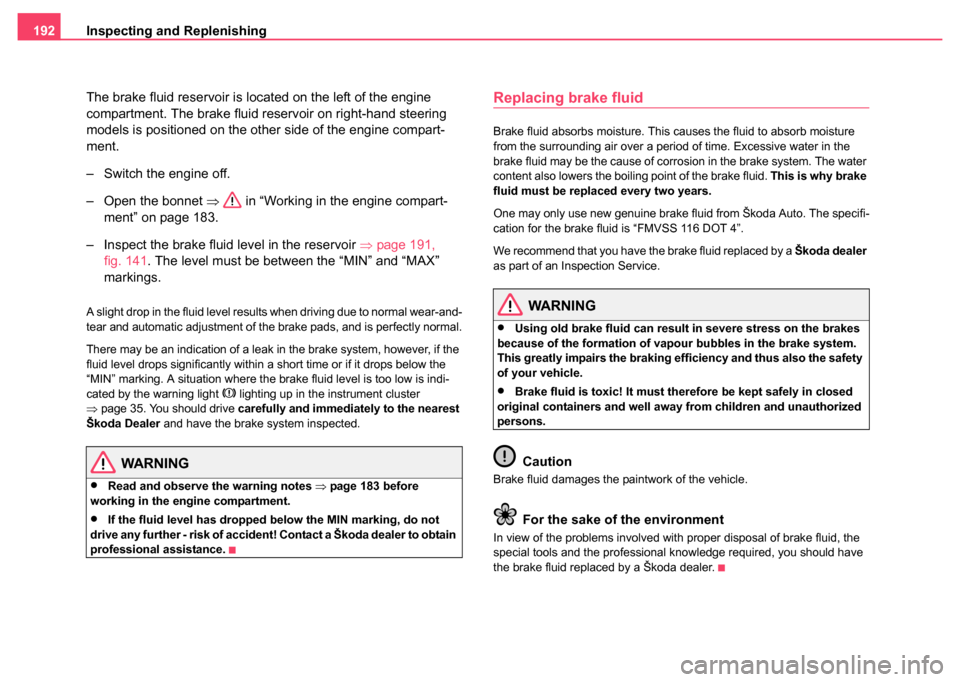
Inspecting and Replenishing
192
The brake fluid reservoir is located on the left of the engine
compartment. The brake fluid reservoir on right-hand steering
models is positioned on the other side of the engine compart-
ment.
– Switch the engine off.
– Open the bonnet ⇒ in “Working in the engine compart-
ment” on page 183.
– Inspect the brake fluid level in the reservoir ⇒page 191,
fig. 141. The level must be between the “MIN” and “MAX”
markings.
A slight drop in the fluid level results when driving due to normal wear-and-
tear and automatic adjustment of the brake pads, and is perfectly normal.
There may be an indication of a leak in the brake system, however, if the
fluid level drops significantly within a short time or if it drops below the
“MIN” marking. A situation where the brake fluid level is too low is indi-
cated by the warning light
lighting up in the instrument cluster
⇒ page 35. You should drive carefully and immediately to the nearest
Škoda Dealer and have the brake system inspected.
WARNING
•Read and observe the warning notes ⇒page 183 before
working in the engine compartment.
•If the fluid level has dropped below the MIN marking, do not
drive any further - risk of accident! Contact a Škoda dealer to obtain
professional assistance.
Replacing brake fluid
Brake fluid absorbs moisture. This causes the fluid to absorb moisture
from the surrounding air over a period of time. Excessive water in the
brake fluid may be the cause of corrosion in the brake system. The water
content also lowers the boiling point of the brake fluid. This is why brake
fluid must be replaced every two years.
One may only use new genuine brake fluid from Škoda Auto. The specifi-
cation for the brake fluid is “FMVSS 116 DOT 4”.
We recommend that you have the brake fluid replaced by a Škoda dealer
as part of an Inspection Service.
WARNING
•Using old brake fluid can result in severe stress on the brakes
because of the formation of vapour bubbles in the brake system.
This greatly impairs the braking efficiency and thus also the safety
of your vehicle.
•Brake fluid is toxic! It must therefore be kept safely in closed
original containers and well away from children and unauthorized
persons.
Caution
Brake fluid damages the paintwork of the vehicle.
For the sake of the environment
In view of the problems involved with proper disposal of brake fluid, the
special tools and the professional knowledge required, you should have
the brake fluid replaced by a Škoda dealer.
Page 213 of 247
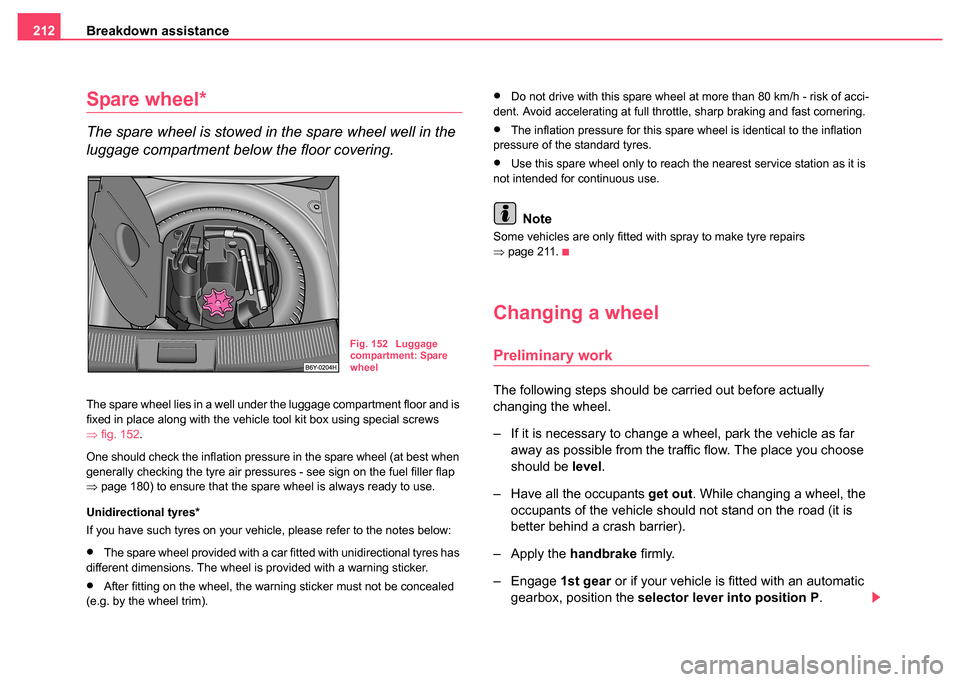
Breakdown assistance
212
Spare wheel*
The spare wheel is stowed in the spare wheel well in the
luggage compartment below the floor covering.
The spare wheel lies in a well under the luggage compartment floor and is
fixed in place along with the vehicle tool kit box using special screws
⇒ fig. 152 .
One should check the inflation pressure in the spare wheel (at best when
generally checking the tyre air pressures - see sign on the fuel filler flap
⇒ page 180) to ensure that the spare wheel is always ready to use.
Unidirectional tyres*
If you have such tyres on your vehicle, please refer to the notes below:
•The spare wheel provided with a car fitted with unidirectional tyres has
different dimensions. The wheel is provided with a warning sticker.
•After fitting on the wheel, the warning sticker must not be concealed
(e.g. by the wheel trim).
•Do not drive with this spare wheel at more than 80 km/h - risk of acci-
dent. Avoid accelerating at full throttle, sharp braking and fast cornering.
•The inflation pressure for this spare wheel is identical to the inflation
pressure of the standard tyres.
•Use this spare wheel only to reach the nearest service station as it is
not intended for continuous use.
Note
Some vehicles are only fitted with spray to make tyre repairs
⇒ page 211.
Changing a wheel
Preliminary work
The following steps should be carried out before actually
changing the wheel.
– If it is necessary to change a wheel, park the vehicle as far
away as possible from the traffic flow. The place you choose
should be level.
– Have all the occupants get out. While changing a wheel, the
occupants of the vehicle should not stand on the road (it is
better behind a crash barrier).
– Apply the handbrake firmly.
– Engage 1st gear or if your vehicle is fitted with an automatic
gearbox, position the selector lever into position P .
Fig. 152 Luggage
compartment: Spare
wheel
Page 221 of 247
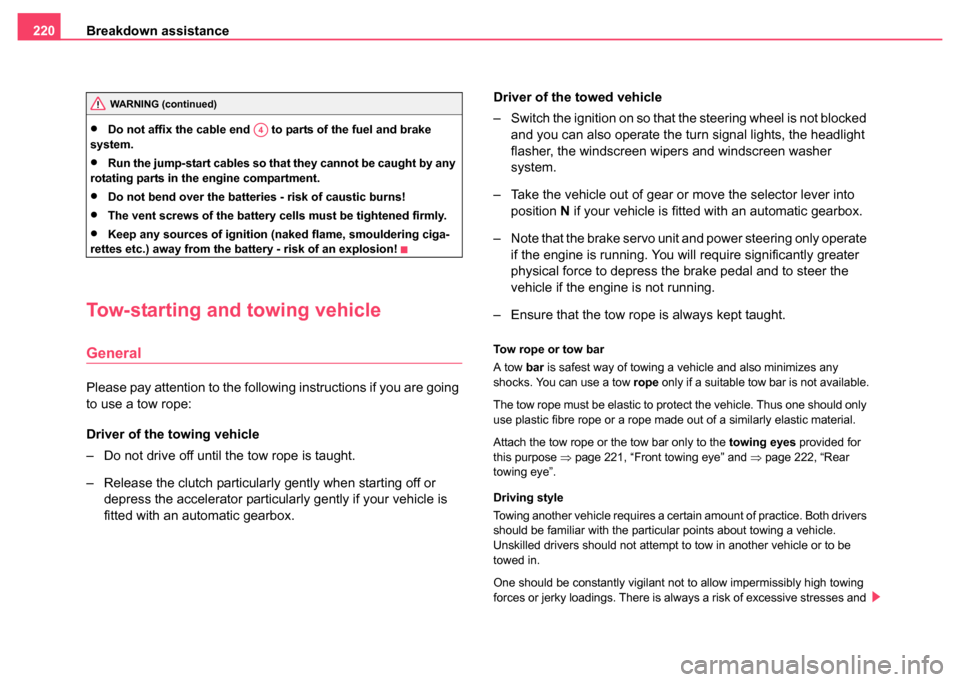
Breakdown assistance
220
•Do not affix the cable end to parts of the fuel and brake
system.
•Run the jump-start cables so that they cannot be caught by any
rotating parts in the engine compartment.
•Do not bend over the batteries - risk of caustic burns!
•The vent screws of the battery cells must be tightened firmly.
•Keep any sources of ignition (naked flame, smouldering ciga-
rettes etc.) away from the battery - risk of an explosion!
Tow-starting and towing vehicle
General
Please pay attention to the following instructions if you are going
to use a tow rope:
Driver of the towing vehicle
– Do not drive off until the tow rope is taught.
– Release the clutch particularly gently when starting off or depress the accelerator particularly gently if your vehicle is
fitted with an automatic gearbox. Driver of the towed vehicle
– Switch the ignition on so that the steering wheel is not blocked
and you can also operate the turn signal lights, the headlight
flasher, the windscreen wipers and windscreen washer
system.
– Take the vehicle out of gear or move the selector lever into position N if your vehicle is fitted with an automatic gearbox.
– Note that the brake servo unit and power steering only operate if the engine is running. You will require significantly greater
physical force to depress the brake pedal and to steer the
vehicle if the engine is not running.
– Ensure that the tow rope is always kept taught.
Tow rope or tow bar
A tow bar is safest way of towing a vehicle and also minimizes any
shocks. You can use a tow rope only if a suitable tow bar is not available.
The tow rope must be elastic to protect the vehicle. Thus one should only
use plastic fibre rope or a rope made out of a similarly elastic material.
Attach the tow rope or the tow bar only to the towing eyes provided for
this purpose ⇒ page 221, “Front towing eye” and ⇒page 222, “Rear
towing eye”.
Driving style
Towing another vehicle requires a certain amount of practice. Both drivers
should be familiar with the particular points about towing a vehicle.
Unskilled drivers should not attempt to tow in another vehicle or to be
towed in.
One should be constantly vigilant not to allow impermissibly high towing
forces or jerky loadings. There is always a risk of excessive stresses and
WARNING (continued)
A4
Page 224 of 247
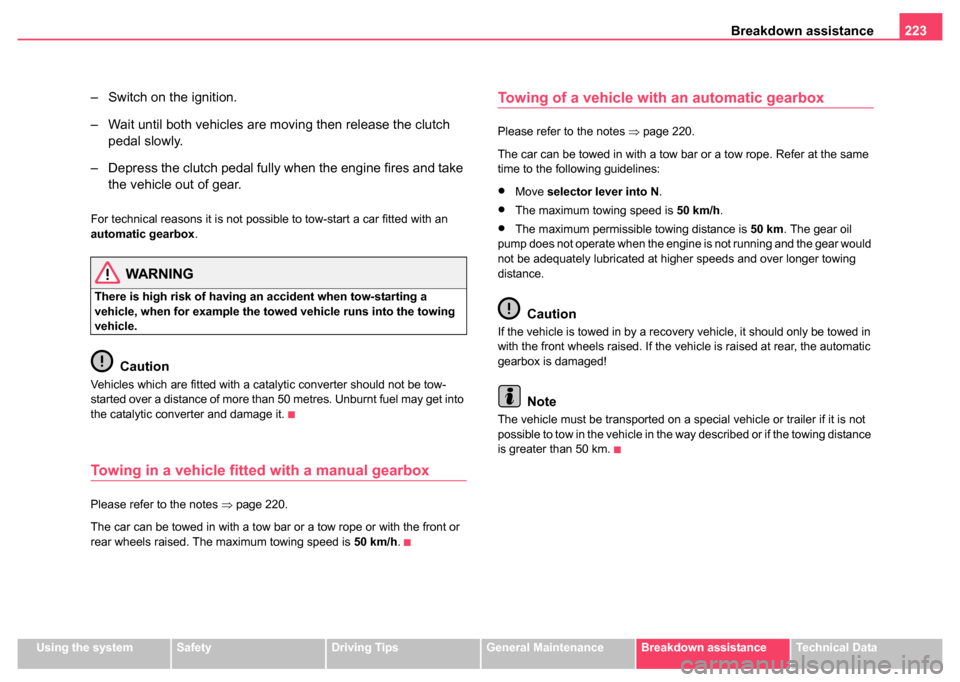
Breakdown assistance223
Using the systemSafetyDriving TipsGeneral MaintenanceBreakdown assistanceTechnical Data
– Switch on the ignition.
– Wait until both vehicles are moving then release the clutch
pedal slowly.
– Depress the clutch pedal fully when the engine fires and take the vehicle out of gear.
For technical reasons it is not possible to tow-start a car fitted with an
automatic gearbox .
WARNING
There is high risk of having an accident when tow-starting a
vehicle, when for example the towe d vehicle runs into the towing
vehicle.
Caution
Vehicles which are fitted with a catalytic converter should not be tow-
started over a distance of more than 50 metres. Unburnt fuel may get into
the catalytic converter and damage it.
Towing in a vehicle fitted with a manual gearbox
Please refer to the notes ⇒page 220.
The car can be towed in with a tow bar or a tow rope or with the front or
rear wheels raised. The maximum towing speed is 50 km/h.
Towing of a vehicle with an automatic gearbox
Please refer to the notes ⇒page 220.
The car can be towed in with a tow bar or a tow rope. Refer at the same
time to the following guidelines:
•Move selector lever into N .
•The maximum towing speed is 50 km/h.
•The maximum permissible towing distance is 50 km. The gear oil
pump does not operate when the engine is not running and the gear would
not be adequately lubricated at higher speeds and over longer towing
distance.
Caution
If the vehicle is towed in by a recovery vehicle, it should only be towed in
with the front wheels raised. If the vehicle is raised at rear, the automatic
gearbox is damaged!
Note
The vehicle must be transported on a special vehicle or trailer if it is not
possible to tow in the vehicle in the way described or if the towing distance
is greater than 50 km.
Page 226 of 247
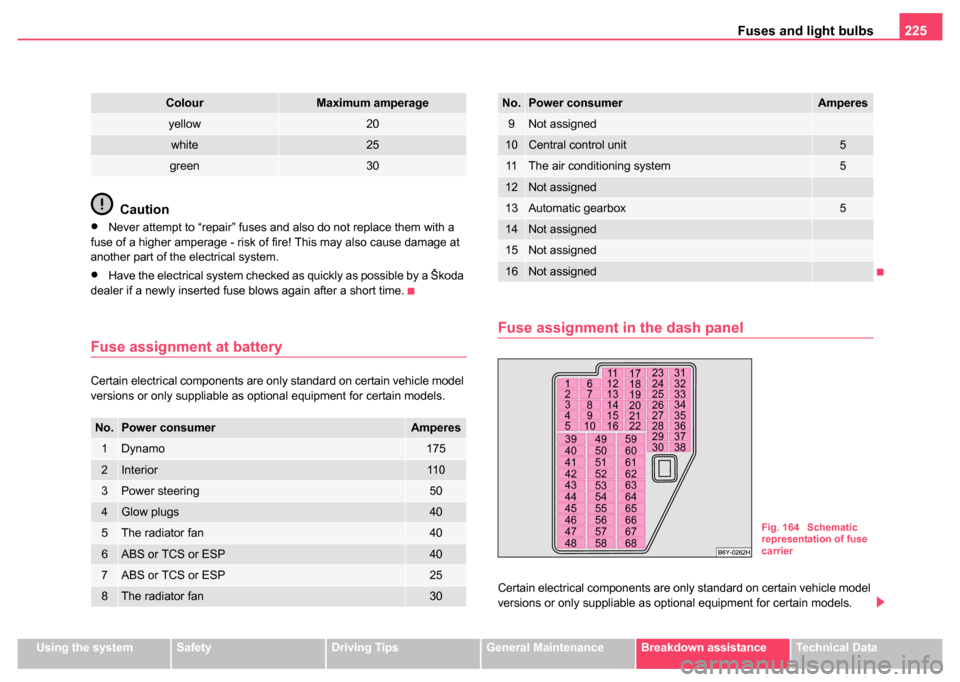
Fuses and light bulbs225
Using the systemSafetyDriving TipsGeneral MaintenanceBreakdown assistanceTechnical Data
Caution
•Never attempt to “repair” fuses and also do not replace them with a
fuse of a higher amperage - risk of fire! This may also cause damage at
another part of the electrical system.
•Have the electrical system checked as quickly as possible by a Škoda
dealer if a newly inserted fuse blows again after a short time.
Fuse assignment at battery
Certain electrical components are only standard on certain vehicle model
versions or only suppliable as optional equipment for certain models.
Fuse assignment in the dash panel
Certain electrical components are only standard on certain vehicle model
versions or only suppliable as optional equipment for certain models.
yellow20
white25
green30
No.Power consumerAmperes
1Dynamo175
2Interior11 0
3Power steering50
4Glow plugs40
5The radiator fan40
6ABS or TCS or ESP40
7ABS or TCS or ESP25
8The radiator fan30
ColourMaximum amperage
9Not assigned
10Central control unit5
11The air conditioning system5
12Not assigned
13Automatic gearbox5
14Not assigned
15Not assigned
16Not assigned
No.Power consumerAmperes
1
2
3
4
5 6
7
8
9
10 12
13
14
15
1611
18
19
20
21
22 17 24
25
26
27
28 23
32
33
34
35
36 31
29 37
30 38
39
40
41
42
43
44
45
46
47
48 49
50
51
52
53
54
55
56
57
5859
60
61
62
63
64
65
66
67
68
Fig. 164 Schematic
representation of fuse
carrier
Page 227 of 247
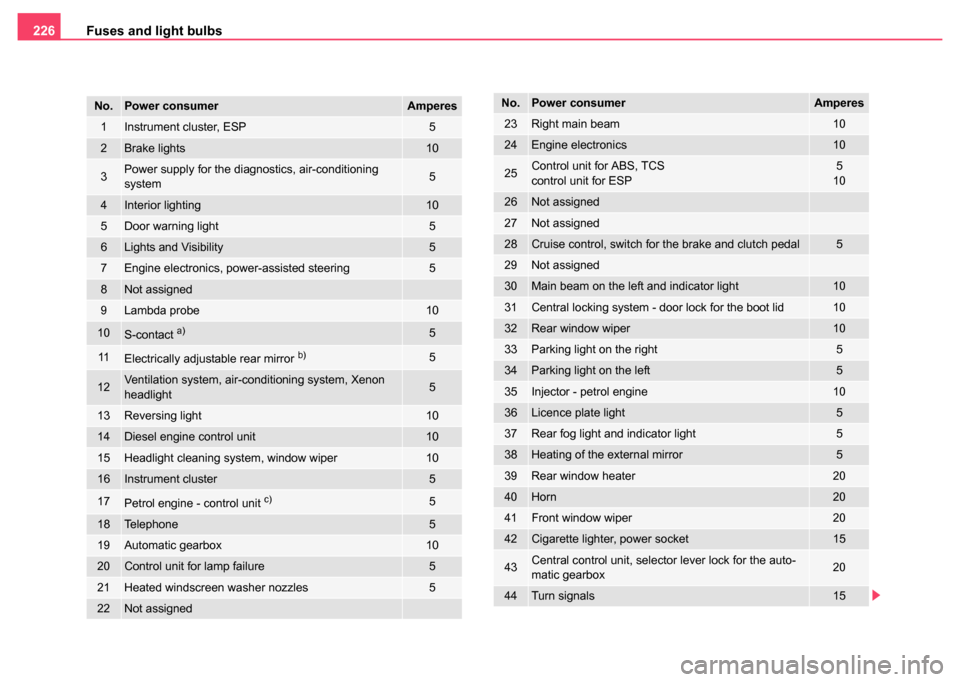
Fuses and light bulbs
226
No.Power consumerAmperes
1Instrument cluster, ESP5
2Brake lights10
3Power supply for the diagnostics, air-conditioning
system5
4Interior lighting10
5Door warning light 5
6Lights and Visibility5
7Engine electronics, power-assisted steering5
8Not assigned
9Lambda probe10
10S-contact a)5
11Electrically adjustable rear mirror b)5
12Ventilation system, air-conditioning system, Xenon
headlight5
13Reversing light10
14Diesel engine control unit10
15Headlight cleaning system, window wiper10
16Instrument cluster5
17Petrol engine - control unit c)5
18Telephone5
19Automatic gearbox10
20Control unit for lamp failure5
21Heated windscreen washer nozzles5
22Not assigned
23Right main beam10
24Engine electronics10
25Control unit for ABS, TCS
control unit for ESP5
10
26Not assigned
27Not assigned
28Cruise control, switch for the brake and clutch pedal5
29Not assigned
30Main beam on the left and indicator light10
31Central locking system - door lock for the boot lid10
32Rear window wiper10
33Parking light on the right5
34Parking light on the left5
35Injector - petrol engine10
36Licence plate light5
37Rear fog light and indicator light5
38Heating of the external mirror5
39Rear window heater20
40Horn20
41Front window wiper20
42Cigarette lighter, power socket15
43Central control unit, selector lever lock for the auto-
matic gearbox20
44Turn signals15
No.Power consumerAmperes
Page 240 of 247
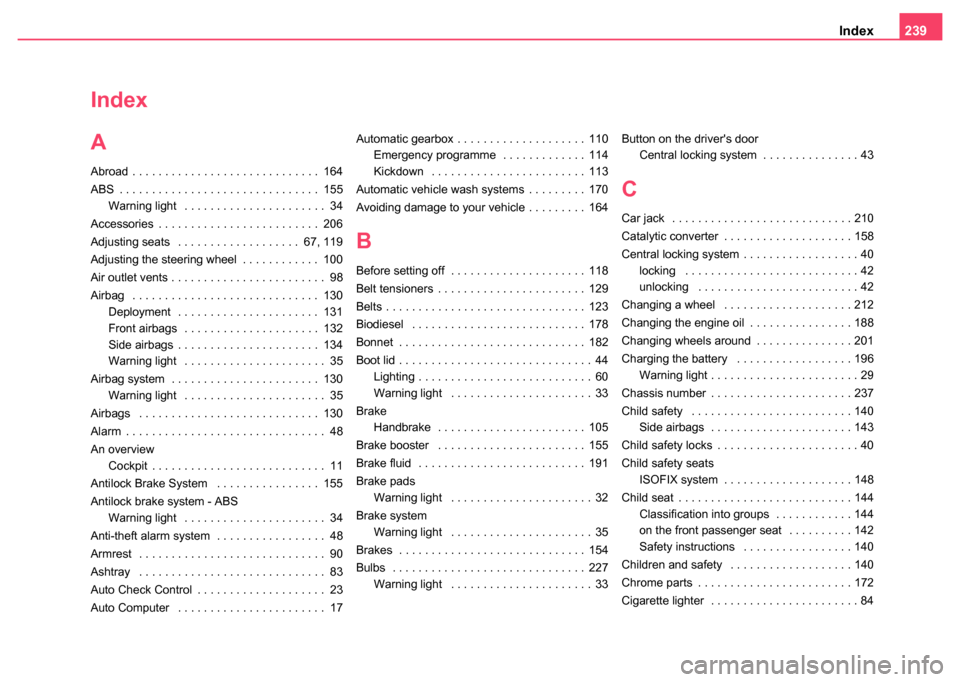
Index239
Index
A
Abroad . . . . . . . . . . . . . . . . . . . . . . . . . . . . . 164
ABS . . . . . . . . . . . . . . . . . . . . . . . . . . . . . . . 155
Warning light . . . . . . . . . . . . . . . . . . . . . . 34
Accessories . . . . . . . . . . . . . . . . . . . . . . . . . 206
Adjusting seats . . . . . . . . . . . . . . . . . . . 67, 119
Adjusting the steering wheel . . . . . . . . . . . . 100
Air outlet vents . . . . . . . . . . . . . . . . . . . . . . . . 98
Airbag . . . . . . . . . . . . . . . . . . . . . . . . . . . . . 130 Deployment . . . . . . . . . . . . . . . . . . . . . . 131
Front airbags . . . . . . . . . . . . . . . . . . . . . 132
Side airbags . . . . . . . . . . . . . . . . . . . . . . 134
Warning light . . . . . . . . . . . . . . . . . . . . . . 35
Airbag system . . . . . . . . . . . . . . . . . . . . . . . 130 Warning light . . . . . . . . . . . . . . . . . . . . . . 35
Airbags . . . . . . . . . . . . . . . . . . . . . . . . . . . . 130
Alarm . . . . . . . . . . . . . . . . . . . . . . . . . . . . . . . 48
An overview Cockpit . . . . . . . . . . . . . . . . . . . . . . . . . . . 11
Antilock Brake System . . . . . . . . . . . . . . . . 155
Antilock brake system - ABS Warning light . . . . . . . . . . . . . . . . . . . . . . 34
Anti-theft alarm system . . . . . . . . . . . . . . . . . 48
Armrest . . . . . . . . . . . . . . . . . . . . . . . . . . . . . 90
Ashtray . . . . . . . . . . . . . . . . . . . . . . . . . . . . . 83
Auto Check Control . . . . . . . . . . . . . . . . . . . . 23
Auto Computer . . . . . . . . . . . . . . . . . . . . . . . 17 Automatic gearbox . . . . . . . . . . . . . . . . . . . . 110
Emergency programme . . . . . . . . . . . . . 114
Kickdown . . . . . . . . . . . . . . . . . . . . . . . . 113
Automatic vehicle wash systems . . . . . . . . . 170
Avoiding damage to your vehicle . . . . . . . . . 164
B
Before setting off . . . . . . . . . . . . . . . . . . . . . 118
Belt tensioners . . . . . . . . . . . . . . . . . . . . . . . 129
Belts . . . . . . . . . . . . . . . . . . . . . . . . . . . . . . . 123
Biodiesel . . . . . . . . . . . . . . . . . . . . . . . . . . . 178
Bonnet . . . . . . . . . . . . . . . . . . . . . . . . . . . . . 182
Boot lid . . . . . . . . . . . . . . . . . . . . . . . . . . . . . . 44 Lighting . . . . . . . . . . . . . . . . . . . . . . . . . . . 60
Warning light . . . . . . . . . . . . . . . . . . . . . . 33
Brake Handbrake . . . . . . . . . . . . . . . . . . . . . . . 105
Brake booster . . . . . . . . . . . . . . . . . . . . . . . 155
Brake fluid . . . . . . . . . . . . . . . . . . . . . . . . . . 191
Brake pads Warning light . . . . . . . . . . . . . . . . . . . . . . 32
Brake system Warning light . . . . . . . . . . . . . . . . . . . . . . 35
Brakes . . . . . . . . . . . . . . . . . . . . . . . . . . . . . 154
Bulbs . . . . . . . . . . . . . . . . . . . . . . . . . . . . . . 227 Warning light . . . . . . . . . . . . . . . . . . . . . . 33 Button on the driver's door
Central locking system . . . . . . . . . . . . . . . 43
C
Car jack . . . . . . . . . . . . . . . . . . . . . . . . . . . . 210
Catalytic converter . . . . . . . . . . . . . . . . . . . . 158
Central locking system . . . . . . . . . . . . . . . . . . 40locking . . . . . . . . . . . . . . . . . . . . . . . . . . . 42
unlocking . . . . . . . . . . . . . . . . . . . . . . . . . 42
Changing a wheel . . . . . . . . . . . . . . . . . . . . 212
Changing the engine oil . . . . . . . . . . . . . . . . 188
Changing wheels around . . . . . . . . . . . . . . . 201
Charging the battery . . . . . . . . . . . . . . . . . . 196 Warning light . . . . . . . . . . . . . . . . . . . . . . . 29
Chassis number . . . . . . . . . . . . . . . . . . . . . . 237
Child safety . . . . . . . . . . . . . . . . . . . . . . . . . 140 Side airbags . . . . . . . . . . . . . . . . . . . . . . 143
Child safety locks . . . . . . . . . . . . . . . . . . . . . . 40
Child safety seats ISOFIX system . . . . . . . . . . . . . . . . . . . . 148
Child seat . . . . . . . . . . . . . . . . . . . . . . . . . . . 144 Classification into groups . . . . . . . . . . . . 144
on the front passenger seat . . . . . . . . . . 142
Safety instructions . . . . . . . . . . . . . . . . . 140
Children and safety . . . . . . . . . . . . . . . . . . . 140
Chrome parts . . . . . . . . . . . . . . . . . . . . . . . . 172
Cigarette lighter . . . . . . . . . . . . . . . . . . . . . . . 84
Page 242 of 247
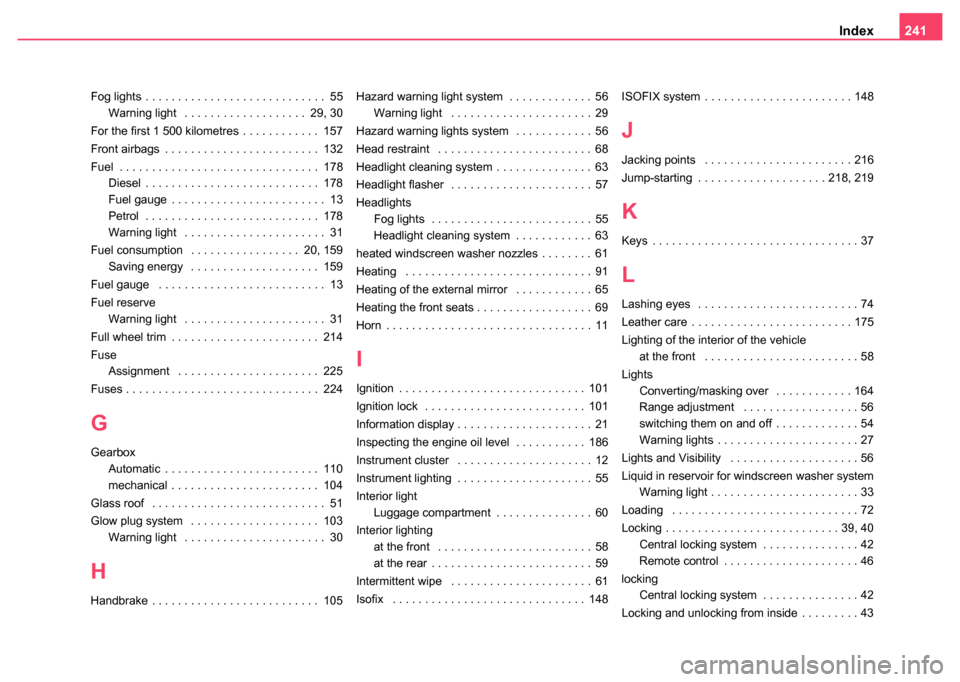
Index241
Fog lights . . . . . . . . . . . . . . . . . . . . . . . . . . . . 55
Warning light . . . . . . . . . . . . . . . . . . . 29, 30
For the first 1 500 kilometres . . . . . . . . . . . . 157
Front airbags . . . . . . . . . . . . . . . . . . . . . . . . 132
Fuel . . . . . . . . . . . . . . . . . . . . . . . . . . . . . . . 178 Diesel . . . . . . . . . . . . . . . . . . . . . . . . . . . 178
Fuel gauge . . . . . . . . . . . . . . . . . . . . . . . . 13
Petrol . . . . . . . . . . . . . . . . . . . . . . . . . . . 178
Warning light . . . . . . . . . . . . . . . . . . . . . . 31
Fuel consumption . . . . . . . . . . . . . . . . . 20, 159 Saving energy . . . . . . . . . . . . . . . . . . . . 159
Fuel gauge . . . . . . . . . . . . . . . . . . . . . . . . . . 13
Fuel reserve Warning light . . . . . . . . . . . . . . . . . . . . . . 31
Full wheel trim . . . . . . . . . . . . . . . . . . . . . . . 214
Fuse Assignment . . . . . . . . . . . . . . . . . . . . . . 225
Fuses . . . . . . . . . . . . . . . . . . . . . . . . . . . . . . 224
G
Gearbox Automatic . . . . . . . . . . . . . . . . . . . . . . . . 110
mechanical . . . . . . . . . . . . . . . . . . . . . . . 104
Glass roof . . . . . . . . . . . . . . . . . . . . . . . . . . . 51
Glow plug system . . . . . . . . . . . . . . . . . . . . 103 Warning light . . . . . . . . . . . . . . . . . . . . . . 30
H
Handbrake . . . . . . . . . . . . . . . . . . . . . . . . . . 105 Hazard warning light system . . . . . . . . . . . . . 56
Warning light . . . . . . . . . . . . . . . . . . . . . . 29
Hazard warning lights system . . . . . . . . . . . . 56
Head restraint . . . . . . . . . . . . . . . . . . . . . . . . 68
Headlight cleaning system . . . . . . . . . . . . . . . 63
Headlight flasher . . . . . . . . . . . . . . . . . . . . . . 57
Headlights Fog lights . . . . . . . . . . . . . . . . . . . . . . . . . 55
Headlight cleaning system . . . . . . . . . . . . 63
heated windscreen washer nozzles . . . . . . . . 61
Heating . . . . . . . . . . . . . . . . . . . . . . . . . . . . . 91
Heating of the external mirror . . . . . . . . . . . . 65
Heating the front seats . . . . . . . . . . . . . . . . . . 69
Horn . . . . . . . . . . . . . . . . . . . . . . . . . . . . . . . . 11
I
Ignition . . . . . . . . . . . . . . . . . . . . . . . . . . . . . 101
Ignition lock . . . . . . . . . . . . . . . . . . . . . . . . . 101
Information display . . . . . . . . . . . . . . . . . . . . . 21
Inspecting the engine oil level . . . . . . . . . . . 186
Instrument cluster . . . . . . . . . . . . . . . . . . . . . 12
Instrument lighting . . . . . . . . . . . . . . . . . . . . . 55
Interior light Luggage compartment . . . . . . . . . . . . . . . 60
Interior lighting at the front . . . . . . . . . . . . . . . . . . . . . . . . 58
at the rear . . . . . . . . . . . . . . . . . . . . . . . . . 59
Intermittent wipe . . . . . . . . . . . . . . . . . . . . . . 61
Isofix . . . . . . . . . . . . . . . . . . . . . . . . . . . . . . 148 ISOFIX system . . . . . . . . . . . . . . . . . . . . . . . 148
J
Jacking points . . . . . . . . . . . . . . . . . . . . . . . 216
Jump-starting . . . . . . . . . . . . . . . . . . . . 218, 219
K
Keys . . . . . . . . . . . . . . . . . . . . . . . . . . . . . . . . 37
L
Lashing eyes . . . . . . . . . . . . . . . . . . . . . . . . . 74
Leather care . . . . . . . . . . . . . . . . . . . . . . . . . 175
Lighting of the interior of the vehicle
at the front . . . . . . . . . . . . . . . . . . . . . . . . 58
Lights Converting/masking over . . . . . . . . . . . . 164
Range adjustment . . . . . . . . . . . . . . . . . . 56
switching them on and off . . . . . . . . . . . . . 54
Warning lights . . . . . . . . . . . . . . . . . . . . . . 27
Lights and Visibility . . . . . . . . . . . . . . . . . . . . 56
Liquid in reservoir for windscreen washer system Warning light . . . . . . . . . . . . . . . . . . . . . . . 33
Loading . . . . . . . . . . . . . . . . . . . . . . . . . . . . . 72
Locking . . . . . . . . . . . . . . . . . . . . . . . . . . . 39, 40 Central locking system . . . . . . . . . . . . . . . 42
Remote control . . . . . . . . . . . . . . . . . . . . . 46
locking Central locking system . . . . . . . . . . . . . . . 42
Locking and unlocking from inside . . . . . . . . . 43